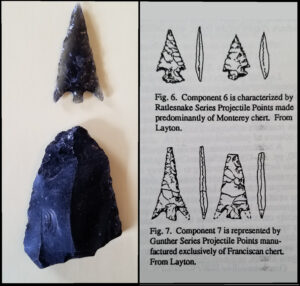An archaeology dig of a Native American camp site on Albion Head? Yes! Of course, it was 40 years ago, but the late Dr. Richard White wrote about it in a short feature story called Prehistory of Albion, found in issue 42 of his “Mendocino Medicine and Gazetteer.”

A publication of medical news for rural practitioners, with added bits of history, biology or geography that attracted his attention, White’s periodical is an interesting read. Bound volumes are on loan to the Kelley House from Deborah White in Ukiah.
In the 1990s, Dr. White read a monograph by Thomas Layton called “Western Pomo Prehistory,” and he shared with readers of his publication some of its conclusions.
Layton, then a San Jose State University professor, conducted an archaeological investigation in the early 1980s on private property on Albion Head about a mile north of the Albion River bridge. He devotes 120 pages of his “Western Pomo Prehistory” to the Albion dig, and while much of it is dry statistical data, it also offers insights into what life was like for thousands of years before the arrival of white settlers. The thing that fascinated me as a rockhound was the interpretation of native life by the origin of the rock and chert used in projectile points.
He and his crew discovered the site was occupied at times by people from the south coast because arrowheads dug up there were made from Monterey chert found near Point Arena – and only west of the San Andreas earthquake fault found in that vicinity. Later occupants of the site used Franciscan chert and obsidian from inland sources. Tools made of Monterey chert were dated back 3,000 years. Franciscan chert and obsidian were only 2,000 years old. Researchers found seven levels of occupation on the site.
The stone was used to make projectile points, spears, knives, drills, and mortar and pestles. Bones were used to make awls, wedges, and beads. From Dr. White’s story about “Seashells of Albion,” which I wrote about recently, there is mention here of Olivella shell beads and abalone shell ornament.
The native peoples visiting the site ate California sea mussels, chitons, limpets, turban snails, and hazelnuts. Fish and rabbit bones were few and far between, but bones of juvenile sea otter, harbor seals, and Roosevelt elk were present with raccoon, mole, gopher, and mouse bones. Food resources like these were gathered at this place for 5,000 years.
The abundance of projectile points suggests an emphasis on mammal hunting. Bones found were consistent with wildlife available in late spring and summer. Occupants of the site understood what we now call “red tide” organisms and avoided collecting shellfish in mid-summer.
The seasonal hunting camp at the Albion site was occupied, then abandoned, repeatedly during prehistory. The people who stayed there brought with them tool kits to make more projectile points and rock to make them from their home territories…like Monterey chert found near Point Arena.
In “Western Pomo Prehistory,” Layton also documents his investigations at two other sites – “Nightbird’s Retreat” west of Calpella near Eagle Peak, and “Three Chop Village” in the coast range west of Willits.
Again, the presence of stone, where it came from, and who brought it, was a topic of interest. Franciscan chert was found, as well as obsidian from inland places such as Mount Konocti, and Lake County “Diamonds,” which are quartz. Along with the rock tools were coastal chiton, mussel, and abalone shells.
The dig at the inland site at “Three Chop Village” yielded some archaeological surprises when they unearthed Chinese ceramic pieces drilled into beads and pieces of green glass bottles flaked into arrow points. Researchers were expecting rock and bone, but Chinese pottery?
These were artifacts from the Frolic, a ship full of Chinese trade goods headed to San Francisco that wrecked south of Caspar in 1850. Chinese pottery on board had found its way inland to the village. This discovery would lead Layton to write two more books, “The Voyage of the Frolic” and “Gifts of the Celestial Kingdom,” that added to our understanding of the story behind white settlement on the coast.
If any history lover is interested in Mendocino County’s native people and their relationship with the land, the detailed bibliography found in ”Western Pomo Prehistory” contains over 400 citations. Layton’s work is long out-of-print but can be found at your local library or viewed by appointment in the Kelley House research office in Mendocino. Contact us at 937-5791 or curator@kelleyhousemuseum.org.